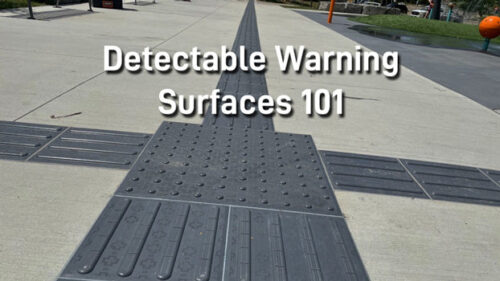The Importance of Detectable Warning Surfaces: Uses, Benefits, and Standards

The Importance of Detectable Warning Surfaces: Uses, Benefits, and Standards
Detectable warning surfaces are essential for the safety and independence of individuals who are blind or have low vision, as they provide a tactile cue to indicate a change in level or the presence of a hazard. They are an important element of accessible design and can be used in many different situations. They are especially useful in public places, where they can alert people who use a cane or guide dog to hazards on the ground that may not be visible to them. Detectable warning surfaces are also known as “tactile warning strips” or “tactile paving”.
Uses of Detectable Warning Surfaces
Detectable warning surfaces are primarily used on sidewalks, curb ramps, and other areas where there is a change in level or a potential hazard for individuals who are blind or have low vision. This includes areas where sidewalks transition to streets, at the edges of platforms at mass transit stations, and at the edges of raised crosswalks. They are also commonly used on the approach to pedestrian push buttons at signalized intersections and at the bottom and top of stairways.
Detectable warning surfaces help to alert individuals with vision loss of a potential hazard. They can be used to indicate the presence of a curb ramp or other change in level, such as at the edge of a platform. They are also used on stairways and ramps where there is no defined edge line or railings.
Benefits of Detectable Warning Surfaces
The primary benefit of a detectable warning surface is the increased safety and independence it provides for individuals who are blind or have low vision. These surfaces serve as a tactile cue that alerts individuals to the presence of a street or other hazard, allowing them to navigate the area safely and with more confidence.
In addition to the safety benefits, detectable warning surfaces also improve accessibility for individuals with visual impairments. They make it easier for these individuals to access and use public transportation, as well as navigate sidewalks and other areas that may be difficult for them to navigate without a visual cue.
Standards for Detectable Warning Surfaces
The Americans with Disabilities Act (ADA) sets standards for detectable warning surfaces in the United States. These standards include the size, spacing, and placement of the truncated domes, as well as the materials that can be used to construct them.
According to the ADA, detectable warning surfaces must be made of durable and slip-resistant material and must be located where they can be easily detected by individuals who are blind or have low vision. The truncated domes must be spaced at a maximum of 2.35 inches apart and must have a diameter of 0.9 inches, with a height of 0.2 inches.
In addition to the ADA standards, the International Building Code (IBC) and the International Residential Code (IRC) also set standards for detectable warning surfaces. These codes require that all curb ramps, platform edges, and other areas where there is a change in level or a potential hazard for individuals who are blind or have low vision must have detectable warning surfaces.
Conclusion
Detectable warning surfaces are an essential safety feature for individuals who are blind or have low vision. They provide a tactile cue that alerts individuals to the presence of a street or other hazard, allowing them to navigate the area safely and with more confidence. In addition to the safety benefits, detectable warning surfaces also improve accessibility for individuals with visual impairments, making it easier for them to access and use public transportation, and navigate sidewalks and other areas. With the standards set by ADA, IBC, and IRC, the installation of detectable warning surfaces is mandatory for the accessibility of visually impaired people.






